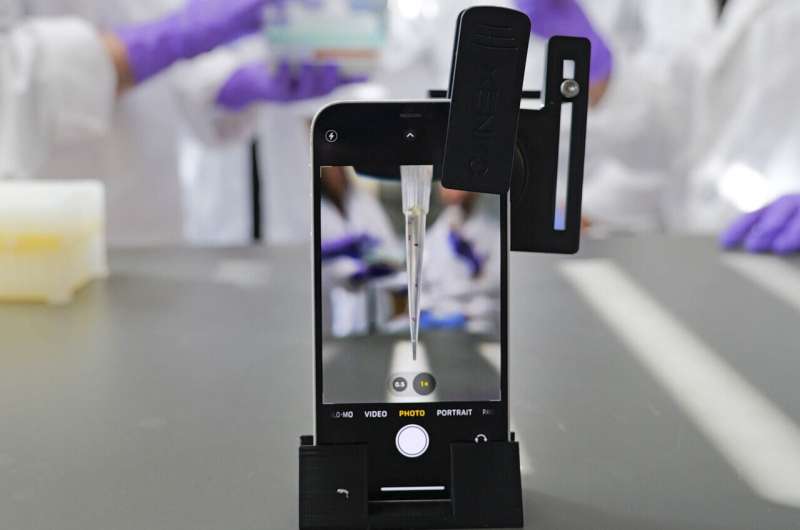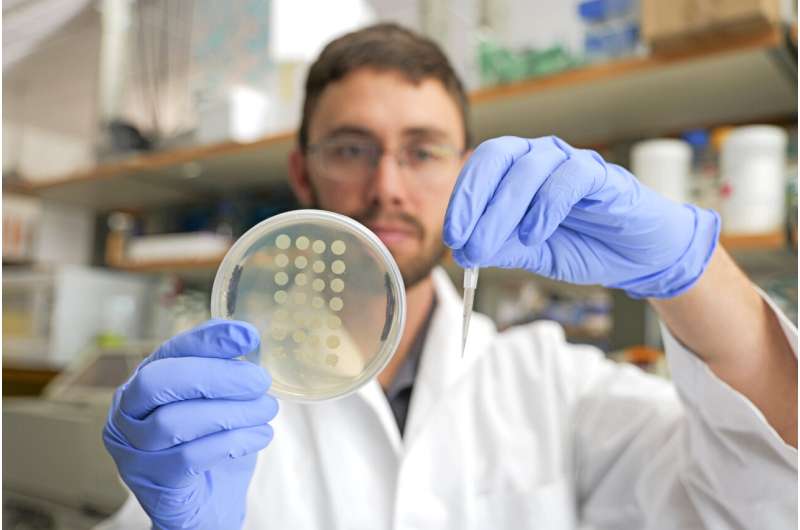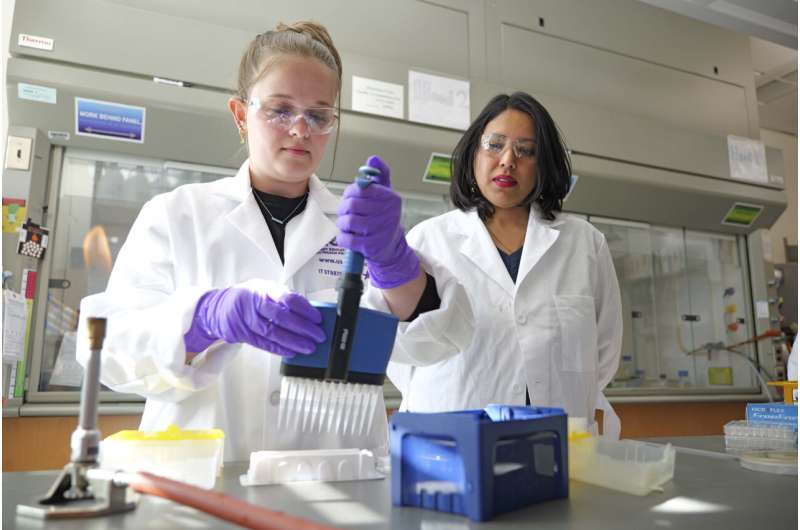This article has been reviewed according to Science X's editorial process and policies. Editors have highlighted the following attributes while ensuring the content's credibility:
fact-checked
peer-reviewed publication
trusted source
proofread
New way to count microbes speeds research, cuts waste, could lead to new antibiotics

University of Colorado Boulder researchers have developed a new way of counting microorganisms that works as much as 36 times faster than conventional methods, cuts plastic use more than 15-fold, and substantially decreases the cost and carbon footprint of biomedical research.
The technique
, described in the journal Nature Microbiology, could revolutionize the way microbiology experiments are conducted around the world, allowing clinicians to diagnose and treat infections faster and researchers to test potential new antibiotics in a fraction of the time. The invention comes as concern about
"We are in the middle of a silent pandemic of antimicrobial resistance and there is an urgent need to speed up the discovery of new antibiotics," said senior author Anushree Chatterjee, associate professor of chemical and biological engineering at CU Boulder. "We believe this new method can do that, and much more."
A new way to fill the pipeline
Since 1938, microbiologists have used a simple method, the colony-forming unit (CFU) assay, for counting bacterial cells in a sample. They start by diluting the sample down into eight to 10 different concentrations, put drops from each into petri dishes filled with bacteria food, wait hours or days for individual colonies to form, and count them. If they are testing a new molecule to see how well it can kill bacteria, they add that in to see how many bacteria survive.
The process is notoriously laborious and wasteful, often taking hours to assess a small sample and producing mounds of discarded plastic.
Because it takes so long and costs so much, researchers must be choosy about which potential new drugs or combinations they test, so they're discouraged from taking chances, Chatterjee said.

This high-cost, low-profit equation has led pharmaceutical companies to steer away from developing new antibiotics.
"We are basically out of antibiotics," said Chatterjee, noting that many widely circulating pathogens—including Staphylococcus aureas (staph) and Neisseria gonorrhoeae (gonorrhea)—are now resistant to most drugs designed to treat them.
"In order to have a sustainable pipeline of new options, we have to fundamentally change the way discovery is done," Chatterjee said.
Math instead of plastic
The new method, known as Geometric Viability Assay (GVA), replaces the arduous multi-step process of manual dilutions with a one-step process, informed by simple geometry and math.
"We are using the same kinds of math that can help students estimate the number of M&M's in a jar," said first author Christian Meyer, a postdoctoral fellow in the departments of Molecular, Cellular and Developmental Biology and Chemical and Biological Engineering. "Instead of counting all the M&M's individually, a clever student might count the bottom layer and then multiply by the height."
Similarly, instead of manually dividing the samples into numerous subsamples to make counting colonies easier, GVA counts colonies in one place, inside a portion of the cone of a single pipette tip, and then uses multiplication to calculate total concentration.
To do this, scientists embed the samples into a gel inside the cone, in which colonies form. When it's time to count, they can use various techniques—including ones that involve taking a picture or using a paper ruler—to accurately measure samples with anywhere from one to 1 billion microbes.
"It involves no mathematics that a high-school calculus student couldn't perform," said Meyer. But it could have a big impact.

Faster, cheaper, greener
In laboratory tests measuring common bacteria like Escherichia coli (E. coli) and Salmonella enterica, the researchers found that while preparing 96 samples took three hours by classical methods, GVA took 5 minutes—a 36-fold time savings. Even when compared to a more modern method involving robotics, GVA was still nine times faster and used one-tenth the plastic.
Using GVA, a single researcher could accurately measure the microbial concentration of 1,200 samples in a single day, the study found.
Ultimately, Chatterjee believes the method could also enable doctors to diagnose infection and find the right antibiotic for that infection faster.
"Instead of someone being in the hospital for three days while they figure out what that particular bug is sensitive to, we could potentially someday know overnight what the right antibiotic might be," she said, noting that more research is needed to advance to the clinical stage. Meyer invented the technique with Joel Kralj, a former assistant professor in the BioFrontiers Institute. The two are working with Venture Partners and have filed a provisional patent.
The research team has also created a website, and are now working to develop a smartphone version that scientists and the general public can use.
"Someone wise once said that the correct punctuation for a scientific advance is not an exclamation mark, but a semicolon," said Meyer. "In that spirit, while we are thrilled to be part of reinventing a core technique of microbiology, we are most excited for what will come next."
More information: Christian T. Meyer et al, A high-throughput and low-waste viability assay for microbes, Nature Microbiology (2023). DOI: 10.1038/s41564-023-01513-9
Journal information: Nature Microbiology
Provided by University of Colorado at Boulder




















